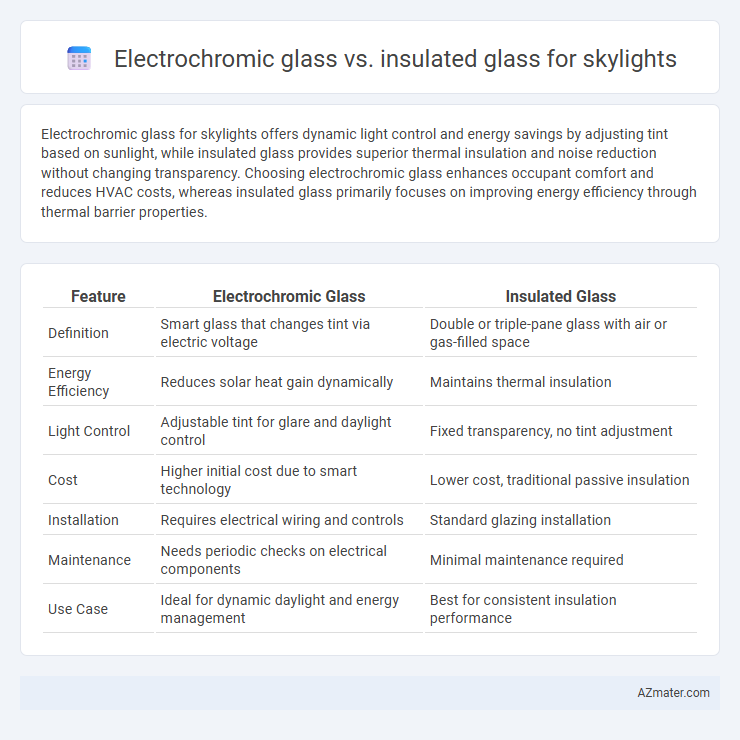Electrochromic glass for skylights offers dynamic light control and energy savings by adjusting tint based on sunlight, while insulated glass provides superior thermal insulation and noise reduction without changing transparency. Choosing electrochromic glass enhances occupant comfort and reduces HVAC costs, whereas insulated glass primarily focuses on improving energy efficiency through thermal barrier properties.
Table of Comparison
| Feature | Electrochromic Glass | Insulated Glass |
|---|---|---|
| Definition | Smart glass that changes tint via electric voltage | Double or triple-pane glass with air or gas-filled space |
| Energy Efficiency | Reduces solar heat gain dynamically | Maintains thermal insulation |
| Light Control | Adjustable tint for glare and daylight control | Fixed transparency, no tint adjustment |
| Cost | Higher initial cost due to smart technology | Lower cost, traditional passive insulation |
| Installation | Requires electrical wiring and controls | Standard glazing installation |
| Maintenance | Needs periodic checks on electrical components | Minimal maintenance required |
| Use Case | Ideal for dynamic daylight and energy management | Best for consistent insulation performance |
Introduction to Skylight Technologies
Electrochromic glass for skylights offers dynamic light control by adjusting tint electronically, enhancing energy efficiency and occupant comfort through smart shading. Insulated glass provides thermal insulation with multiple glass layers separated by an air or gas-filled space, reducing heat transfer and improving building energy performance. Both technologies optimize natural light utilization while addressing energy conservation and indoor climate management.
What is Electrochromic Glass?
Electrochromic glass is a smart glazing technology that changes its tint automatically or on demand to control the amount of light and heat passing through skylights, improving energy efficiency and occupant comfort. Unlike insulated glass, which relies on multiple glass panes and air or gas-filled spaces for thermal insulation, electrochromic glass actively modulates solar heat gain and glare without the need for blinds or shades. This advanced functionality reduces cooling costs and enhances natural daylighting while maintaining clear views when the glass is in its transparent state.
What is Insulated Glass?
Insulated glass consists of two or more glass panes separated by a gas-filled space that enhances thermal insulation, reducing heat transfer and improving energy efficiency in skylights. Unlike electrochromic glass, which changes tint electronically to control light and heat, insulated glass provides consistent insulation without active solar control. This makes insulated glass ideal for maintaining temperature stability and reducing condensation in skylight installations.
Light Control Capabilities: Electrochromic vs Insulated Glass
Electrochromic glass offers dynamic light control by tinting on demand to reduce glare and solar heat gain, enhancing comfort and energy efficiency in skylights. Insulated glass provides fixed light transmission with thermal insulation but lacks the adjustable shading capabilities of electrochromic technology. For applications requiring variable daylight and glare management, electrochromic glass delivers superior light modulation compared to traditional insulated glass.
Energy Efficiency Comparison
Electrochromic glass for skylights offers dynamic solar control by adjusting tint levels to reduce heat gain and enhance natural light management, resulting in significant energy savings in cooling and lighting. Insulated glass, composed of multiple sealed panes with inert gas fills, primarily improves thermal insulation by minimizing heat transfer but lacks active solar modulation capabilities. Energy efficiency in skylights is optimized by electrochromic glass through adaptive shading, whereas insulated glass relies on static thermal resistance, making electrochromic technology superior for environments with variable sunlight exposure.
Thermal Performance and Comfort
Electrochromic glass offers dynamic solar control by adjusting tint levels to reduce heat gain and glare, enhancing thermal comfort in skylight applications. Insulated glass improves thermal performance through multiple panes and air or gas-filled cavities, minimizing heat transfer and condensation. While insulated glass provides consistent insulation, electrochromic glass optimizes occupant comfort by actively responding to changing sunlight conditions.
Cost Differences and ROI Analysis
Electrochromic glass for skylights typically incurs higher upfront costs, ranging from $100 to $200 per square foot, compared to insulated glass priced between $25 and $50 per square foot. While insulated glass offers basic thermal insulation, electrochromic glass provides dynamic solar control, reducing HVAC energy costs by up to 30%, thereby accelerating return on investment within 5 to 7 years depending on climate and building usage. ROI analyses often highlight electrochromic glass's superior long-term energy savings and occupant comfort benefits, outweighing its initial premium in commercial and high-performance building applications.
Installation and Maintenance Considerations
Electrochromic glass for skylights offers advanced installation requirements due to integrated electrical components and control systems, necessitating professional expertise to ensure proper wiring and sealing. Insulated glass, meanwhile, features simpler installation with standard framing but demands careful handling to prevent seal failure, which can cause condensation and reduced thermal performance. Maintenance of electrochromic glass involves periodic system checks and potential electrical repairs, whereas insulated glass primarily requires inspection for seal integrity and glass damage to maintain insulation efficiency.
Sustainability and Environmental Impact
Electrochromic glass for skylights significantly reduces energy consumption by dynamically controlling solar heat gain and natural daylight, lowering the need for artificial cooling and lighting, which directly minimizes carbon footprints. In contrast, insulated glass primarily offers thermal insulation benefits but lacks active light modulation, resulting in less efficient energy management over time. The sustainability advantage of electrochromic glass lies in its adaptive technology that enhances building energy performance and reduces environmental impact throughout its lifecycle.
Choosing the Best Skylight Solution
Electrochromic glass offers dynamic tinting capabilities that regulate solar heat and glare, enhancing energy efficiency and occupant comfort in skylights, while insulated glass primarily provides static thermal insulation to reduce heat transfer. Choosing the best skylight solution depends on factors like climate, energy savings goals, and budget, with electrochromic glass ideal for environments requiring adaptive light control and insulated glass suitable for consistent insulation performance. Integrating electrochromic technology can increase upfront costs but delivers long-term energy savings and improved daylight management compared to traditional insulated glass skylights.

Infographic: Electrochromic glass vs Insulated glass for Skylight
 azmater.com
azmater.com